|
|
|
Sort Order |
|
|
|
Items / Page
|
|
|
|
|
|
|
| Srl | Item |
| 1 |
ID:
169716
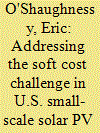

|
|
|
|
|
| Summary/Abstract |
Solar photovoltaic (PV) prices have fallen significantly over the past two decades. These price reductions have relied primarily on falling system hardware costs. Future reductions in PV prices—which are needed to ensure that enough PV will be deployed to meet global clean energy objectives—will require reductions in non-hardware or “soft” costs, particularly in markets with relatively high soft costs such as the United States. In this article, we draw insights from the literature on which factors affect soft costs for small-scale PV systems in the United States. The literature shows that soft costs tend to be lower for systems that are larger, installed during new construction, installed by more experienced installers, installed in more concentrated markets and in more competitive markets, installed in markets where customers receive more quotes, or installed in markets with less onerous permitting requirements. We identify three marketplace design strategies that policymakers could pursue to address the soft cost challenge in the United States and similar markets: encourage the expansion of quote platforms; encourage or require that PV system installation be integrated into the new construction and roof replacement process; and encourage the expansion of customer aggregation models such as Solarize campaigns and community solar.
|
|
|
|
|
|
|
|
|
|
|
|
|
|
|
|
| 2 |
ID:
169719


|
|
|
|
|
| Summary/Abstract |
PV-battery systems are currently not operated in an energy system optimal way as their operation heuristic (maximization of self-consumption) is generally unaffected by competitive market signals. To evaluate potential regulatory intervention, we propose a market alignment indicator which measures the relative economic efficiency of a prosumer battery compared to a benchmark system that is completely responsive to wholesale market prices. Investigating the case of PV-battery systems in Germany, we find that scarcity signals transmitted to prosumers improve the market alignment of PV-battery systems while retaining similar levels of self-consumption and autarky rates. Both dynamic prices for generation (time-varying feed-in remuneration) and consumption (real-time electricity prices) can improve welfare, that is lowering consumer expenditures for electricity at the wholesale market. The effectiveness of the respective instrument mix depends on the relative levels of the feed-in tariff, the grid consumption to be saved and the solar generation costs. Accordingly, increasing fixed network charges can have a significant positive impact on the market alignment of prosumer batteries if combined with dynamic prices, as they change the relative composition of retail prices.
|
|
|
|
|
|
|
|
|
|
|
|
|
|
|
|
| 3 |
ID:
169749
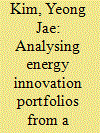

|
|
|
|
|
| Summary/Abstract |
A systemic perspective on energy innovation is required to design effective portfolios of directed innovation activity. We contribute a standardised set of technology-specific indicators which describe processes throughout the energy technology innovation system, ranging from patents and publications to policy mixes, collaborative activity, and market share. Using these indicators, we then conceptualise and develop benchmark tests for three portfolio design criteria: balance, consistency, and alignment. Portfolio balance refers to the relative emphasis on specific technologies. Portfolio consistency refers to the relative emphasis on related innovation system processes. Portfolio alignment refers to the relative emphasis on innovation system processes for delivering targeted outcomes. We demonstrate the application of these benchmark tests using data for the EU's Strategic Energy Technology (SET) Plan which spans six technology fields. We find the SET Plan portfolio generally performs well particularly in areas over which portfolio managers have direct influence such as RD&D funding. However we also identify potential areas of imbalance, inconsistency, and misalignment which warrant further attention and potential redress by portfolio managers. Overall, we show how energy innovation portfolios can be analysed from a systemic perspective using a replicable, standardised set of measures of diverse innovation system processes.
|
|
|
|
|
|
|
|
|
|
|
|
|
|
|
|
| 4 |
ID:
169713
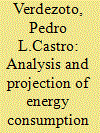

|
|
|
|
|
| Summary/Abstract |
A forecast model for the Ecuador energy sector was elaborated, by using LEAP model, this study aims to analyze the behavior of the energy matrix depending on energy forecast and efficiency policy scenarios, applying a bottom-up analysis and considering the latest politics/infrastructure planning background in Ecuador. The model and considerations proposed will result in a final energy consumption of 158 million BOE in 2030, in which the transportation sector is the main energy consumer. Regarding Ecuador energy planning, of which a critical point is the hydroelectricity available due to the commissioning of new hydro power plants, estimated at 63,513 Gwh in 2030, this value is 3.25 times that generated in 2010. In addition, the energy saving of 15 million BOE is forecast, as well as the reduction in GHG emission related to that saving due to the energy efficiency program PEC, which replaces LPG stoves with induction stoves in Ecuadorian households. Results point out that energy efficiency policies for the transportation sector would reduce oil products (2.97% in the high growth scenario), which could be reallocated to the industrial sector. Finally, another critical point is the rapid decline in the oil self-sufficiency, estimated at 15 years counted from 2030.
|
|
|
|
|
|
|
|
|
|
|
|
|
|
|
|
| 5 |
ID:
169747
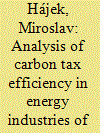

|
|
|
|
|
| Summary/Abstract |
A carbon tax is one of economic policy instruments of environmental protection supposed to contribute to the reduction of greenhouse gas (GHG) emissions. A functional carbon tax aims at incorporating costs for elimination of environmental harm into the pricing decisions. In terms of global climate change, the carbon tax is usually imposed on the production, distribution or consumption of carbon-content fossil fuels. The main aim of the study is to evaluate the carbon tax environmental effectiveness in the energy industries of selected EU countries, namely Sweden, Finland, Denmark, Ireland and Slovenia. To achieve the principal research objective, the multiple panel regression method for the selected variables was used, the synergy of other environmental policy tools being taken into account. Control variables employed were emission allowance price, household final consumption expenditure, corporate investments, solid fuel consumption and renewable energy consumption. The analysis results suggest that the carbon tax in the energy industry is environmentally efficient, an increased tax rate allowing to reduce GHG production, which is statistically significantly affected by the consumption of fossil fuels. Based on the estimated partial regression coefficient (−0.01158), raising the carbon tax by one euro per tonne can cut annual per capita emissions by 11.58 kg.
|
|
|
|
|
|
|
|
|
|
|
|
|
|
|
|
| 6 |
ID:
169730


|
|
|
|
|
| Summary/Abstract |
Experts predict continuing deployment of wind turbines in the United States, which will create more interactions between turbines and surrounding communities. Policymakers can benefit from analyses of existing wind projects that enable them to better understand likely effects on residents around proposed projects. Our analysis of a randomly drawn, representative national survey of 1705 existing U.S. wind project neighbors provides previously unavailable detail about factors influencing the attitudes of these neighbors toward their local wind projects. Overall, we find positive-leaning attitudes, which improve over time as individuals self-select into communities near existing wind projects. Hearing wind turbines leads to less-positive attitudes, although living very near to turbines does not, nor does seeing wind turbines. In fact, our findings suggest complex relationships among nearby residents’ attitudes, their perceptions about the particular fit of turbines within their landscape and community, and their perceptions of wind project impacts on property values. These findings—along with the positive correlation between perceived planning-process fairness and attitude—suggest areas of focus for wind project development that may influence social outcomes and acceptance of wind energy. The concluding discussion provides a number of policy and future research recommendations based on the research.
|
|
|
|
|
|
|
|
|
|
|
|
|
|
|
|
| 7 |
ID:
169718
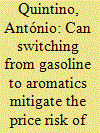

|
|
|
|
|
| Summary/Abstract |
Oil prices wide fluctuations have been a constant in energy economics, influencing heavily the profits of oil companies. Even small oil prices changes imply wide variations in the refining margins, the main economic drivers of the profits of oil companies with relevant refining assets. The future will bring an even more volatile environment as the level of implementation of low-carbon policies increases, implying a declining demand for refined products for internal combustion engine vehicles. One of the possible paths to mitigate the refining margin volatility and the decreasing demand for refined products is to switch gasoline production to aromatics products, through new aromatics plants. In this paper we apply the copula-GARCH model with Monte Carlo simulation to evaluate the economic impacts of this production switching, supporting a European oil company's decision. The results show that the product switch success depends on gasoline prices and on how the aromatics plant is built, if in stand-alone mode or integrated with the refinery. It is also shown that the desired reduction of the integrated refining margin volatility is not achieved with the product switching.
|
|
|
|
|
|
|
|
|
|
|
|
|
|
|
|
| 8 |
ID:
169741


|
|
|
|
|
| Summary/Abstract |
A growing number of cities have set ambitious mid-century targets for greenhouse gas (GHG) emissions reduction and increased use of renewable energy. Using the municipal jurisdiction of Vancouver, Canada as a case study, we integrated an energy-economy model with an urban land-use and infrastructure model to test the possible actions resulting from policies potentially available to this city government in pursuit of its 2050 target of 100 percent renewable energy and an 80 percent reduction of GHG emissions. We found that, while cities like the one we studied have some important options for reducing energy use by their inhabitants, they may lack the authority to completely transform the energy system, especially for causing a wholesale switch to renewable energy for deep decarbonization. To achieve such ambitious energy and GHG targets, cities with jurisdictional powers comparable to the city we studied are dependent to some degree on complementary GHG and energy policies from senior levels of government.
|
|
|
|
|
|
|
|
|
|
|
|
|
|
|
|
| 9 |
ID:
169743


|
|
|
|
|
| Summary/Abstract |
This paper estimates changes in the cost of electricity, reliability, and atmospheric emissions resulting from large penetration of residential roof-top Photovoltaic (PV) and end-use energy efficiency (EE) within the service areas of Duke Energy in the Carolinas, where nuclear power plants account for almost 50% of electricity generation.
|
|
|
|
|
|
|
|
|
|
|
|
|
|
|
|
| 10 |
ID:
169721


|
|
|
|
|
| Summary/Abstract |
The use of uneconomic virtual transactions in day-ahead electricity markets with the intent to benefit related financial positions constitutes cross-product manipulation, and has emerged as a policy concern in recent years. Developing analytical frameworks and models to explain the means for achieving sustained day-ahead price manipulation is a challenge. This paper presents a two-stage equilibrium model of day-ahead price manipulation to enhance the value of financial transmission rights (FTRs). We cast the problem as a Stackelberg game between manipulating traders in the day-ahead market (leaders) and generating firms, grid operator and traders without FTRs in the day-ahead and real-time markets (followers). The model accounts for features specific to electricity systems, like intertemporal constraints of power generating units and real-time uncertainty, and considers imperfect competition as a condition allowing manipulation in equilibrium. We simulate hourly financial trading and operations decisions in a small test system for 24 hours. Results suggest that cross-product manipulation is sustained in equilibrium only when both physical and financial participants engage in Cournot competition. Further, as a result of loop flows, price separation between FTR source and sink may be induced by virtual transactions at network locations that are not on the FTR path.
|
|
|
|
|
|
|
|
|
|
|
|
|
|
|
|
| 11 |
ID:
169748
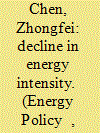

|
|
|
|
|
| Summary/Abstract |
Global energy intensity has decreased significantly during the past two decades. Against this background, this study aims to investigate a novel relationship between development of the financial system (financial development) and energy intensity and explore the underlying mechanisms influencing the relationship between these two indicators. Using long-term country-level data and a two-way fixed-effect model, this study reveals that financial development exerts a significant negative effect on energy intensity for non-OECD countries. However, financial development has a limited impact on energy reduction for OECD countries as a result of the mature financial systems of these developed economies. The estimated results are robust for various specifications. In addition, we reveal a U-shaped relationship between financial development and energy intensity in developing countries. Our results suggest that the influence of financial development on energy intensity reduction can be achieved through technological progress and innovation. Our findings suggest that stimulating financial development is an efficient way to reduce national energy intensity, and specific long-term policies must be established in order to balance the trade-off between financial development, economic growth, and energy intensity.
|
|
|
|
|
|
|
|
|
|
|
|
|
|
|
|
| 12 |
ID:
169725
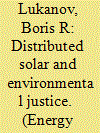

|
|
|
|
|
| Summary/Abstract |
The rapid growth of distributed solar adoption in California provides an opportunity to lower electricity bills for the adopters and realize additional community benefits, including grid resilience and lower grid emissions. It is unclear, however, whether this transition is occurring equitably across the state's various demographic and socioeconomic groups and whether historically disadvantaged environmental justice (EJ) communities have been able to exploit the bill savings and other associated benefits of rooftop solar. Here we analyze the cumulative and annualized (spatial and temporal) rates of PV adoption across California and compare those with data from the state's cumulative impact EJ methodology (CalEnviroScreen). We find persistently lower levels of PV adoption in disadvantaged communities, suggesting clear distributive and equity impacts of existing PV support policies, and indicating that the benefits bypass some of the state's most vulnerable populations. The analysis reveals strong correlation of solar adoption with not only socioeconomic variables, but also with health, environmental and demographic indicators, contributing to our growing understanding of the role these factors play in household clean-energy adoption trends. The results provide a baseline from which to develop more effective policies, strategically design incentives, and track the efficacy of existing solar programs that target disadvantaged communities.
|
|
|
|
|
|
|
|
|
|
|
|
|
|
|
|
| 13 |
ID:
169753


|
|
|
|
|
| Summary/Abstract |
Fuel economy standards are a key measure to increase the rate of efficiency improvements in passenger cars. The fuel consumption of vehicles can be improved in three ways: incremental technical efficiency improvements within powertrain technologies, market shifts to more efficient types of powertrains and by limiting increases in the size and performance of vehicles. This study quantifies the effect of each of these three drivers on the fuel consumption of British vehicles between 2001 and 2018 using driver-reported data on real-world fuel consumption. Analysis shows the introduction of EU fuel economy standards in 2008/09 had little effect on the rate of real technical efficiency improvements in British vehicles. Instead of adopting technical improvements at a higher rate or limiting the size and power of vehicles, these results suggest vehicle manufacturers met emissions standards by increasing the divergence between laboratory tests and real-world fuel consumption. This study adds to the growing literature calling for official test procedures to be representative of real-world driving.
|
|
|
|
|
|
|
|
|
|
|
|
|
|
|
|
| 14 |
ID:
169759


|
|
|
|
|
| Summary/Abstract |
In this paper, we test the weak and strong versions of the Porter hypothesis using data from 14 OECD countries over the period 1990–2011. Our analysis makes two contributions to the literature on the topic. First, we use a newly released environmental policy stringency index (EPS) provided by the OECD as an indicator for the stringency of environmental regulations, which addresses the multi-dimensionality of environmental regulations. Second, as a suitable method to deal with asymmetric distributions of the dependent variables, we use a panel-quantile regression model, which allow us to test whether or not the hypothesis holds for all quantiles of the distribution of the corresponding dependent variable. The findings indicate that in the short term a more strict environmental policy is associated with an increase in the number of patent applications and in total factor productivity (TFP) for the highest quantiles of the distribution of patents and for all quantiles of TFP, respectively. Moreover, environmental stringency has a positive effect on research and development expenditures (RD) only in the lower quantiles (10, 25). In the long term, the EPS is affecting RD, patents and TFP in all quantiles, and hence more stringent environmental regulations promote cleaner production processes that could help improving energy efficiency.
|
|
|
|
|
|
|
|
|
|
|
|
|
|
|
|
| 15 |
ID:
169733
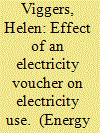

|
|
|
|
|
| Summary/Abstract |
The aim of this paper is to examine the effect of receiving a voucher for electricity on the electricity use of a household. The Warm Homes for Elder New Zealanders Study was a randomised controlled trial which gave participants aged over 55 with chronic obstructive pulmonary disease a voucher providing NZ$500 credit to their electricity account for one winter. Electricity use increased over the winter the participant received the voucher. Participants with lower initial electricity use increased their consumption by about 10%, those with medium- or high-initial use by 2–3%. However, most participants did not use the entire value of the voucher on additional electricity. The study involved only a small informational component: this consisted of a brochure sent to the participants to encourage them to increase their energy use. This was designed to mimic the effects of a possible widespread rollout of this programme. The policy implication of this analysis is that a winter energy voucher accompanied by minimal education was effective at increasing winter energy use among a vulnerable sub-population with a health condition that merited additional heating in winter.
|
|
|
|
|
|
|
|
|
|
|
|
|
|
|
|
| 16 |
ID:
169724
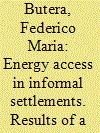

|
|
|
|
|
| Summary/Abstract |
This paper presents the results of a survey on two informal settlements in Rio De Janeiro: Reta Velha (Itaboraí) and Jardim Bom Retiro (São Gonçalo). A detailed analysis of energy access and energy poverty level has been accomplished by questionnaires carried out in 400 households. The questionnaire was based on a detailed multi-tier approach. It was aimed at exploring the actual energy access and energy poverty in favelas, in addition to draw the local living conditions and the availability of the basic services. The outcomes of the research underline the problem of outages and low tension, and illegal connections. Furthermore, electricity consumption is very high compared to the service provided, and expenditures are generally disproportioned to the households’ income. Many interesting outcomes emerge from the survey. Referring to energy poverty, it is a status in which 50% of households are in Jardim Bom Retiro and 20% in Reta Velha. Due to the representativeness of the treated case, the results permit the definition of the state of the art and of enhancing guidelines suitable also for other contexts, at least in the universe of informal settlements in Latin America and Caribbean.
|
|
|
|
|
|
|
|
|
|
|
|
|
|
|
|
| 17 |
ID:
169712


|
|
|
|
|
| Summary/Abstract |
Effective policy requires comprehensive analysis of many factors. But presently there does not exist a sufficiently comprehensive research on the interrelationship between energy input and output, carbon emissions, and water use in the oil and gas extraction process. To more comprehensively measure this phenomenon, this paper constructs an assessment model of energy return on energy, carbon, and water investment for the development of oil and gas resources using the Daqing and Shengli oilfields as practical examples. The results show that the method for evaluating energy input and output (energy return on energy invested) can be made more comprehensive for covering the resources required in the oilfield extraction process; this method ignores the environmental impacts of carbon emissions (energy return on carbon) and water use (energy return on water). However, the energy return evaluation method, which considers energy, carbon, and water inputs, is more comprehensive and practically used to evaluate the development status of oil and gas resources as well as other types of energy development processes. Policy implications for biophysical input accounting and the management of energy resource extraction are given accordingly.
|
|
|
|
|
|
|
|
|
|
|
|
|
|
|
|
| 18 |
ID:
169736


|
|
|
|
|
| Summary/Abstract |
We extend and use the PRIMES energy model to explore pathways towards climate-neutrality in the EU by 2050 and 2070 and analyse implications on energy demand, supply and costs. We draw on the modelling, data and scenario framework developed by the authors to support the European Commission's “Clean Planet for All” communication, released in November 2018. Based on model results for numerous scenarios and sensitivity runs, we analyse key issues to explore feasibility, uncertainties, costs and priorities for climate-neutrality strategy. We suggest that a sustainable climate-neutral energy system in the EU is feasible using known technologies. We emphasise that the EU's climate and energy package for 2030 currently in legislation is not sufficient to ensure climate neutrality by 2050. We characterise as of “no-regret” options promoting energy efficiency, renewables and electrification where cost-effective. However, carbon neutrality also necessitates alternative options of “disruptive” nature. Technologies supporting the disruptive options are not yet mature in industry. High uncertainty surrounds their learning potential. Their deployment heavily depends on policies facilitating investment. The system analysis based on the model illustrates the importance of sectoral integration. We argue that hydrogen, and to a certain extent synthetic carbon-neutral hydrocarbons, are critical elements among the disruptive options.
|
|
|
|
|
|
|
|
|
|
|
|
|
|
|
|
| 19 |
ID:
169734
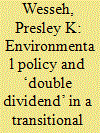

|
|
|
|
|
| Summary/Abstract |
Although the environmental benefit from implementing a climate tax is usually realized, the economic dividend still remains a controversial issue warranting further research. This is because the impact of an environmental policy on an economy-wide system will depend on factors that differ from one region to the next. In this paper, we develop a static CGE model for Liberia that is capable of analyzing both a uniform and a partial carbon tax policy. Under the uniform policy instituted to ensure mitigation in the range of 20–50%, an economic dividend is found for energy, employment, and welfare. In particular, energy consumption increases by between 5 and 15.5%, respectively. Interestingly, under a second best policy which exempts economically strategic sectors from the tax, no economic dividend is found for all three variables. This time, energy use declines by between 2 and 9%. These suggest that a uniform environmental tax policy is a more viable option for Liberia, in particular, as it does not only generate economic dividend for employment and welfare, it also incentivizes Liberia's adoption and use of renewable energy technologies. In general, based on the results obtained, further conditions for the feasibility of a double dividend are proposed.
|
|
|
|
|
|
|
|
|
|
|
|
|
|
|
|
| 20 |
ID:
169755
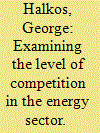

|
|
|
|
|
| Summary/Abstract |
During the recent decades, the energy sector has undergone thoughtful structural changes, getting towards a more competitive environment, a process that is highly controlled and monitored by regulatory authorities. The differences in the pace and extent of market reforms are mainly related to the starting point of each reform and the problems associated with the internal environment of the market. The applied theoretical and analytical contributions provide guidance to policy-makers and government officials in designing new policy scenarios for the investigation of the role of competition in the energy sector. The empirical contributions provide evidence to support and inform current policy debates and should be of benefit to policy-makers and researchers worldwide.
|
|
|
|
|
|
|
|
|
|
|
|
|
|
|
|
|
|
|
|
|